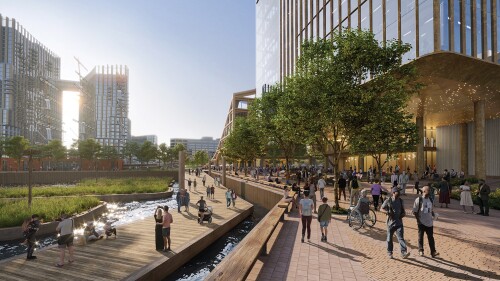Investors are starting to look at the risk of climate change differently, said speakers at the inaugural ULI Asia Pacific Leadership Convivium. However, China’s preparedness to invest in infrastructure should help mitigate those risks.
Held in Shenzhen in March, the convivium was the first of its kind, a themed conference with a high degree of audience discussion and involvement. It considered a number of topics related to the growth of the Greater Bay Area in southern China as well as more general issues for real estate in Asia and elsewhere.
Billy Grayson, executive director of the ULI Center for Sustainability and Economic Performance, said that if sea levels rose two meters (6.5 ft) this century, as some models predict, then large swaths of the Greater Bay Area, which encompasses Shenzhen, Hong Kong, Macau, and nine other cities, would be inundated.
“This is an incredibly economically vibrant region and it’s also a region that’s going to see a population increase of 15 percent within the next 20 years. You’ll see a dramatic increase in the number of inundated areas within this area if proactive action is not taken to mitigate these risks,” Grayson said.
“However, one of the great things also about this region is there’s also a tremendous amount of momentum to mitigate this risk. This is a region that is going to make the investments necessary in infrastructure and buildings to figure out innovative ways to mitigate this risk,” said Grayson. “Some of the areas that are going to be affected by climate change haven’t made the amazing investments in next-generation infrastructure that this region has made.
“I had the opportunity to serve on an Advisory Services panel in Wuhan in the last year. It was amazing to see how much the city and the private sector were invested in creating a net-zero sustainable city of the future,” said Grayson.
Grayson was joined by Mary Ludgin, head of global investment research at Heitman, to introduce a joint report from the investment manager and ULI titled Climate Risk and Real Estate Investment Decision-Making, which examines the risks that climate change poses to real estate and the measures leading firms against it.
Ludgin said: “Real estate investment is about location, location, location. What climate risk does, though, is to magnify that risk. As an example, when you buy an asset, you’re taking on a bundle of risks specific to that investment. But in the era of climate risk, we’re all taking on the risks of the ability of the municipality to provide a subway system to get people to the more building.”
She said that investors need to focus on making their portfolios resilient—not just at the asset level, but also at the location level. A disproportionate amount of prime real estate in the Asia Pacific region and the rest of the world is in coastal areas and therefore at greater risk from rising sea levels and extreme weather events.
There will be climate winners and losers among the world’s cities, with temperate climates and proximity to water key advantages, she said. “My hometown of Chicago has access to the sixth-largest body of freshwater in the world and ours is not a wildly friendly climate, but it is not expected to get worse over the next 20 years. So Chicago ranks nicely on the list of climate winners.”
Technology will be an important factor in real estate becoming more resilient, she said. “Big data allows us to get an assessment of historical incidents at a specific geographical location of various things such as flood, wildfire, and other climate risks, as well as the ability to overlay history on the future. Or to overlay future climate change and weather change maps over the existing information, allowing us to pinpoint risks at the asset level.”
Grayson concluded: “So, the takeaways from this study were that people should be invested in mitigation, hardening your current assets when it’s cost-effective. You should engage your cities to mitigate climate risks and you should be thinking about opportunities for a portfolio that are hedged and diversified away from that risk.”
Audience discussions focused on the environmental problems facing China, the most pressing of which is poor air quality. It was suggested that location risk, with regard to climate change, could in part be mitigated by leveraging existing building certifications to encompass communities, districts, or even cities.




